Have you heard of the benefits or planting in raised ornamental garden beds, but you’re wondering “what can I plant here that will thrive in the conditions and look amazing?” Then, you’ve come to the right place because that’s exactly what you’ll learn in this article.
A raised bed is an elevated garden usually filled with some type of mixture of potting mix, soil and compost, often contained within a wooden, metal, or stone frame. This method of gardening offers distinct growing environments compared to traditional in-ground planting.
First of all, we’ll go over some of the basic growing conditions common in raised planter beds, some of the pros and cons of using raised beds, and then we’ll go over a list of some amazing plants that will suit the space – including screens, small shrubs, ground covers and strappy plants. You’ll notice a clear focus on native Australian plants with a few exotics sprinkled throughout.

These raised beds allow plants to cascade over the sides, and have a strong colour palette of greens, yellows and oranges. https://www.shutterstock.com/image-photo/artistic-street-decorations-raised-rectangular-flower-1500212861
Growing Environments for a Raised Bed
Soil Quality and Composition
- Controlled Soil Quality: Raised beds allow gardeners to precisely control the soil quality, which can be manipulated to suit the needs of particular plants by combining optimal amounts of compost, fertiliser, and well-drained soil. This is especially beneficial in gardens with poor soil.
- Improved Drainage: The elevated nature of raised beds ensures better drainage, reducing the risk of waterlogging and root rot.
Sunlight and Temperature
- Enhanced Warmth: The soil in raised beds tends to warm up more quickly in the spring compared to the ground, allowing for earlier planting.
- Increased Sunlight Exposure: Raised beds can be positioned to maximise exposure to sunlight, crucial for photosynthesis and plant growth.
Weed and Pest Control
- Reduced Weed Growth: The controlled environment of a raised bed can reduce the invasion of weeds, making maintenance easier.
- Pest Management: Elevated beds can be less accessible to some ground-dwelling pests, though they may attract others.
Benefits of Raised Beds
- Soil Customisation: Allows for precise tailoring of soil conditions to meet plant needs.
- Better Drainage: Reduces risks associated with poor drainage.
- Extended Growing Season: Warmer soil extends the growing season.
- Ease of Access: Easier to manage without bending, ideal for individuals with mobility issues and people in wheelchairs.
- Aesthetic Appeal: Can enhance the visual appeal of a garden space.
Drawbacks of Raised Beds
- Initial Cost: The construction of raised beds can be costly, requiring materials and soil.
- Watering Needs: Raised beds may dry out more quickly, necessitating more frequent watering.
- Limited Space: The confined area of raised beds can restrict the growth of larger plants and trees.
- Tough Growing Conditions: Without irrigation, the excess drainage and heat can scorch some plants and can commonly lead to premature plant death.
Plant Characteristics for Thriving in Raised Beds
- Compact Root Systems: Plants with shallow or compact root systems are ideal as the depth of soil is limited.
- High Water Efficiency: Drought-resistant or water-efficient plants perform well due to the potential for quicker soil drying.
- Soil Preference: Plants that thrive in well-drained, rich soil benefit from the customised soil mix of raised beds.
- Sunlight Tolerance: Sun-loving plants that require full sun can be positioned optimally for maximum light exposure. Obviously, a planter box in the shade won’t get as hot, dry, or sunny as a planter box in full sun.
Styling Planter Boxes for Optimal Space Utilisation
Styling planter boxes effectively can transform an urban space, garden or patio, making the best use of available space while creating an aesthetically pleasing environment. By considering factors such as colour, texture, form, shapes, and layers, you can design planter boxes that not only maximise space but also enhance the visual appeal of your outdoor area.
Colour
Selecting a cohesive colour palette for both the plants and the containers can create a harmonious look. You might opt for vibrant, contrasting colours to make a bold statement, or choose muted, complementary tones for a more subdued, elegant appearance. Additionally, consider the colour of the planter boxes themselves: neutral shades like grey, black, or white can provide a modern backdrop, allowing the plants’ colours to pop, while brightly coloured boxes can inject energy and personality into the space. Warm colours like red, orange and yellow excite the passions, while cool colours like blue, green and purple can calm the passions.
Texture
Texture adds depth and interest to planter boxes. Combining plants with varying textures—such as the coarse leaves of succulents, the needle-like leaves of westringia, and the smooth surfaces of glossy lilly pilly leaves—creates a dynamic visual effect. The planter box material also contributes to the overall texture. Wooden boxes offer a rustic charm, metal ones add contemporary sleekness, and ceramic containers can provide a touch of traditional elegance. Mixing different textures within the same planter or amongst several planters can result in a more engaging and layered design.
Form and Shape
The form and shape of the plants and planter boxes significantly impact the overall aesthetic and functionality of the space. Tall, upright plants can add height and structure, while trailing varieties soften edges and create a cascading effect. Similarly, mixing different shapes of planter boxes—rectangular, square, round, and troughs—can break the monotony and add visual interest. Grouping plants with different forms together helps to balance the composition and ensures that no single element dominates the space.
Layers
Creating layers within planter boxes helps make the most of vertical and horizontal space. Layering involves arranging plants at varying heights and depths to create a sense of fullness and dimension. Start with taller plants at the back or centre (depending on where people will view it from) and gradually move to shorter plants at the front or edges. This tiered approach ensures that all plants receive adequate light and are visible, contributing to a lush, well-organised display. Don’t forget the ground-covering plants which can be a lot more exciting than relying on mulch to cover the surface. And embrace the cascading appearance of trailing and strappy plants, which blur the edges of a raised bed beautifully.
Using Vertical Space
Incorporating vertical elements can maximise limited space, especially in small gardens or patios. Consider using tiered planters, columnar shrubs, climbers, hanging baskets, and/or wall-mounted planters to elevate some of your greenery. Vertical gardening not only saves floor space but can also create striking visual points and make the area feel more expansive.
Grouping and Spacing
Effective use of space also involves strategic grouping and spacing of planter boxes. Clustering several planters of varying sizes and shapes can create a focal point and add complexity to the design. Ensure there’s enough space between planters for easy maintenance and to prevent overcrowding, which can impede plant growth and health. Thoughtful spacing allows each plant to thrive and the arrangement to look intentional and well-considered. Plant labels should give you info on a plant’s mature size – otherwise, search for this info online. Remember that different cultivated varieties within the same species can differ drastically in their growth habits.
Seasonal Considerations
Styling planter boxes should also take into account seasonal variations. Plan for seasonal rotation by choosing plants that can be easily swapped as the weather changes, or choose plants that flower or add interest synergistically throughout the year. This keeps the display fresh and vibrant year-round. Incorporate evergreens or perennial plants as the backbone of your design, supplemented by seasonal annuals for bursts of colour and variety.
Flirt™ Nandina domestica ‘MURASAKI’ PBR
Flirt™ Nandina is a tidy, resilient plant that can tolerate full sun to moderate shade, drought, and neglect. It’s up to you whether you’d like to trim it or allow it to reach its mature size and shape of a short bushy shrub. When other nandinas are red in winter, it is green and when other nandinas are green in summer, it is red.
Size
Flirt™ Nandina grows to around 30 – 40cm high x 40 – 50cm wide. The recommended spacing is 4-6 plants per m², 2-4 plants per linear metre.
Climate Tolerance
Flirt™ Nandina can tolerate frost, drought, and tolerates most soils including light sandy and heavy clayey soils. It is suitable for the following regions:
- Queensland
- New South Wales
- Australian Capital Territory
- Victoria
- South Australia
- Western Australia
- Tasmania
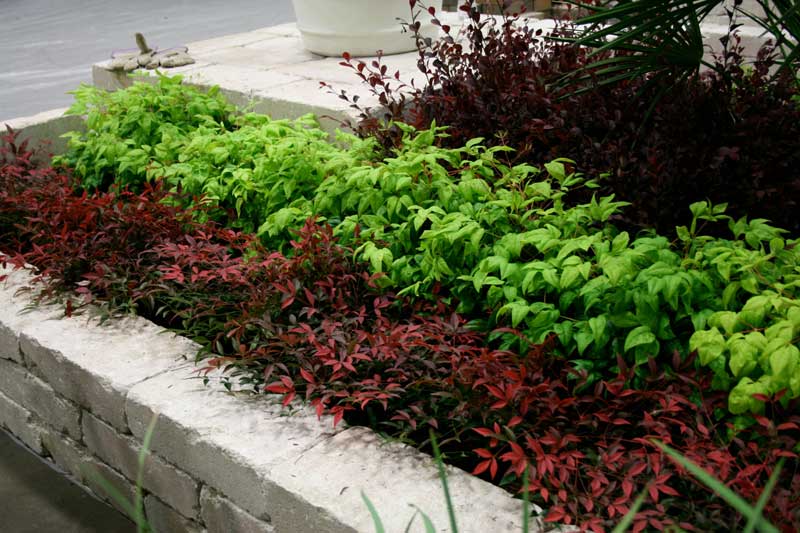
https://www.ozbreed.com.au/plant-ranges/hardy-exotic-range/flirt-nandina/
Evergreen Baby™ Lomandra labill ‘LM600’ PBR
Evergreen Baby™ Lomandra is a compact, fine-leaved variety of Lomandra. Renowned for its toughness, this plant is both wet feet tolerant and drought resistant, making it an excellent choice for planter beds where you don’t trust the irrigation. One of its standout features is the abundance of golden flowers it produces in spring, adding vibrant colour to any garden space. Additionally, this plant is male sterile, reducing the likelihood of unwanted seeding.
Size
Evergreen Baby™ Lomandra typically reaches a height and width of 40-45 cm. For optimal results in raised planter beds, it is recommended to space the plants 4-8 per square metre or 2-4 per linear metre. This density ensures a lush, cohesive look while allowing each plant enough room to flourish.
Climate Tolerance
Evergreen Baby™ Lomandra thrives in various climatic conditions and can tolerate frost, drought, and occasional wet feet. It is suitable for the following regions:
- Queensland (excluding northern Queensland)
- New South Wales
- Australian Capital Territory
- Victoria
- South Australia
- Western Australia

https://www.ozbreed.com.au/plant-ranges/strappy-leaf-plants/evergreen-baby-lomandra/
Isabella® Liriope muscari ‘LIRF’ PBR
Isabella® Liriope is a fine-leaved, compact spreading plant with beautiful pink flowers. This plant is particularly valued for its ability to perform better than Mondo grass in full sun, drought, and frost conditions, and it also recovers well from damage. Its low maintenance requirement of just one mow per year makes it an appealing choice for many gardeners. This is an excellent low-growing plant for the front of a planter box, where its foliage will drape nicely over the edge.
Size
Isabella® Liriope typically reaches a height of 40 cm and a width of 50 cm. For optimal coverage, it is recommended to plant 6-12 plants per square metre or 4-8 plants per linear metre.
Climate Tolerance
Isabella® Liriope thrives in a wide range of climatic conditions, tolerating full sun to 90% shade, as well as frost, drought, and humidity. It is suitable for all soil types and can be grown successfully in:
- New South Wales
- Australian Capital Territory
- Queensland
- Victoria
- South Australia
- Western Australia
- Tasmania
- Northern Territory

https://www.ozbreed.com.au/plant-ranges/strappy-leaf-plants/isabella-liriope/
Amethyst™ Liriope muscari ‘LIRTP’ PBR
Amethyst™ Liriope is a compact, dark green variety of Liriope with striking, long-lasting, deep purple flowers that are held high above the emerald green foliage during the summer. This plant forms strappy clumps and remains evergreen throughout the year, maintaining a reasonable colour in winter unlike some other Liriope forms.
Size
Amethyst™ Liriope typically reaches a height and width of 40 cm. For optimal results, it is recommended to plant 6-10 plants per square metre or 3-5 plants per linear metre.
Climate Tolerance
Amethyst™ Liriope thrives in full sun to moderate and heavy shade, and it suits all soil types. It is highly tolerant of frost, drought, and humidity, making it suitable for all of Australia:
- New South Wales
- Australian Capital Territory
- Queensland
- Victoria
- South Australia
- Western Australia
- Tasmania
- Northern Territory
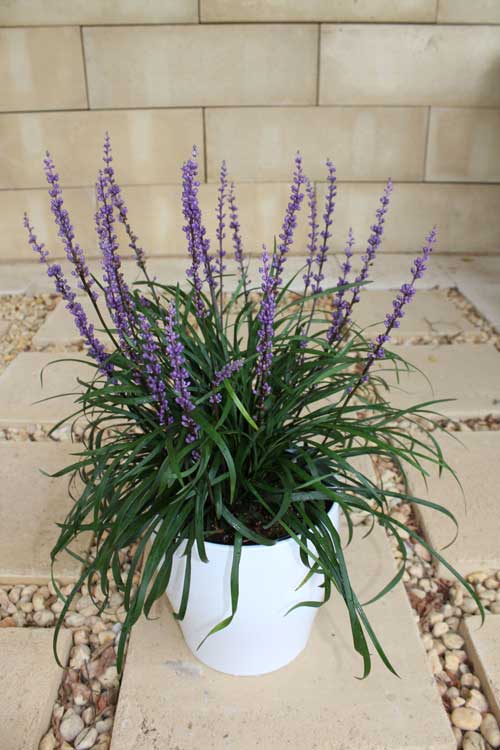
https://www.ozbreed.com.au/plant-ranges/strappy-leaf-plants/amethyst-liriope/
Little Jess™ Dianella caerulea ‘DCMP01’ PBR
Little Jess™ Dianella is a dwarf variety of Dianella characterised by its short, compact canes and clumping growth habit. This plant has minimal maintenance requirements, needing trimming approximately every 8 years. It produces masses of purple flowers from September to November and is exceptionally drought-tolerant, even more so than other Dianella caerulea varieties, such as Breeze® Dianella.
Size
Little Jess™ Dianella typically reaches a height and width of 40 cm. For optimal results, it is recommended to plant 6-10 plants per square metre or 3-5 plants per linear metre.
Climate Tolerance
Little Jess™ Dianella thrives in full sun to moderate and heavy shade. It is highly tolerant of drought, humidity, and frost, making it suitable for:
- New South Wales
- Australian Capital Territory
- Queensland
- Victoria
- South Australia
- Western Australia
- Tasmania

https://www.ozbreed.com.au/plant-ranges/strappy-leaf-plants/little-jess-dianella/
Sweet Mist® Phormium tenax ‘PH0S2’ PBR
Sweet Mist® Phormium is an ultra-compact, bronze-coloured variety of Phormium. Known for its stunning colour contrast, this plant is exceptionally tough, boasting cleaner foliage and greater resilience than other varieties like Elfin and Bronze Baby. Its low maintenance requirements and versatility make it ideal for modern gardens, because bronze tones are in vogue.
Size
Sweet Mist® Phormium typically reaches a height and width of 40 cm. For optimal results, it is recommended to plant 6-10 plants per square metre or 3-5 plants per linear metre.
Climate Tolerance
Sweet Mist® Phormium thrives in full sun to partly shaded positions and tolerates frost and moderate dry conditions. It is suitable for various soil types, particularly preferring free-draining soil. In Sydney, it requires a shaded position and irrigation, except for coastal areas where it can handle full sun. This plant is suitable for the following regions:
- Victoria
- Tasmania
- South Australia
- Western Australia
- Australian Capital Territory
- New South Wales (not suited to north of Sydney)
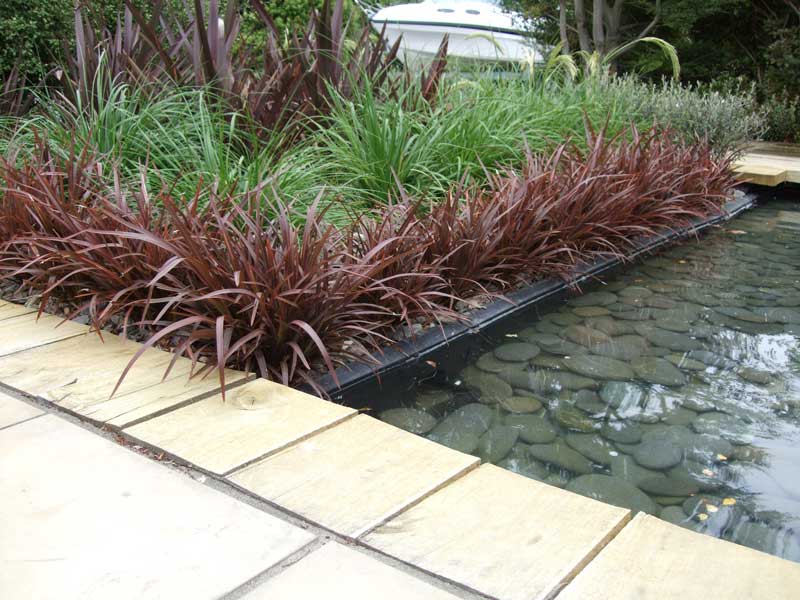
https://www.ozbreed.com.au/plant-ranges/strappy-leaf-plants/sweet-mist-phormium/
Tasred® Dianella tasmanica ‘TR20’ PBR
Tasred® Dianella is a tough, adaptable, and reliable plant with a striking appearance and exceptional performance. It is the best-performing, biggest-selling Dianella tasmanica in Australia. This plant often develops a red base in cold climates or changes from solid green to green with reddish tinges at times. It boasts a dense, tidy appearance with wide, attractive leaves and large purple berries during spring and summer. Tasred® Dianella is an excellent native alternative to Phormium and offers great erosion control capabilities, strengthening the soil by 215% according to a 2007 study (Layt and Paananen).
Size
Tasred® Dianella typically reaches a height of 45 cm and a width of 40-50 cm. For optimal results, it is recommended to plant 4-6 plants per square metre or 2-4 plants per linear metre.
Climate Tolerance
Tasred® Dianella thrives in full sun to heavy shade and is tolerant of frost and heat. It suits sandy, sandy loam, and clay-dominant soils but should be avoided in very poor soils. In Sydney’s northern regions, it is suited to shaded areas only, except for climates like the Blue Mountains. This plant is suitable for the following regions:
- New South Wales
- Australian Capital Territory
- Victoria
- Tasmania
- South Australia
- Western Australia
- Queensland (only for non-humid regions like Toowoomba with free-draining soil)
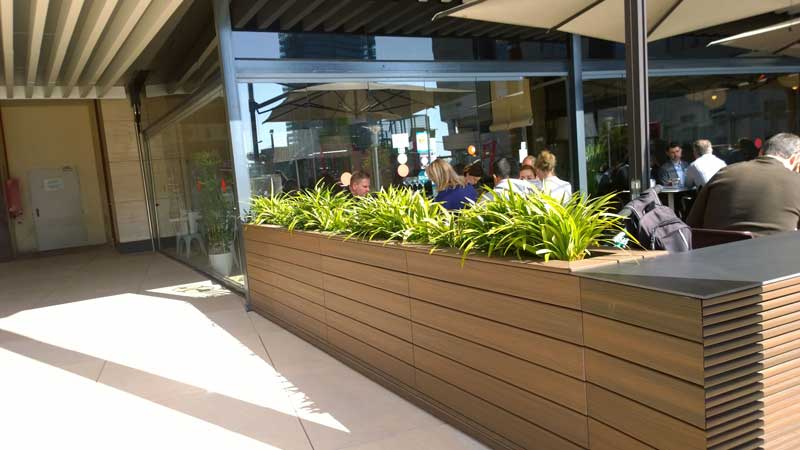
https://www.ozbreed.com.au/plant-ranges/strappy-leaf-plants/tasred-dianella/
Tanika® Lomandra longifolia ‘LM300’ PBR
Tanika® Lomandra is one of the toughest and most reliable landscape plants ever bred, having performed exceptionally well across Australia for over a decade. This evergreen plant features an improved compact fine leaf form, making it a low maintenance favourite among landscape professionals and gardeners. It produces small yellow flowers from April to October and has soft foliage and flower spikes that are safe and enjoyable for children. Tanika® Lomandra is ideal for drought tolerance in raised beds but is not recommended for humid or wet growing conditions.
Size
Tanika® Lomandra typically reaches a height of 50-60 cm and a width of 65 cm. For optimal results, it is recommended to plant 3-6 plants per square metre or 2-3 plants per linear metre.
Climate Tolerance
Tanika® Lomandra thrives in full sun to moderate shade and tolerates frost and drought. It suits a range of soil types, including sandy, sandy loam, and clay soils, but should avoid wet feet and humidity. This plant is suitable for the following regions:
- New South Wales
- Australian Capital Territory
- Victoria
- South Australia
- Western Australia
- Tasmania
- Queensland (only for non-humid regions like Toowoomba with free-draining soil)
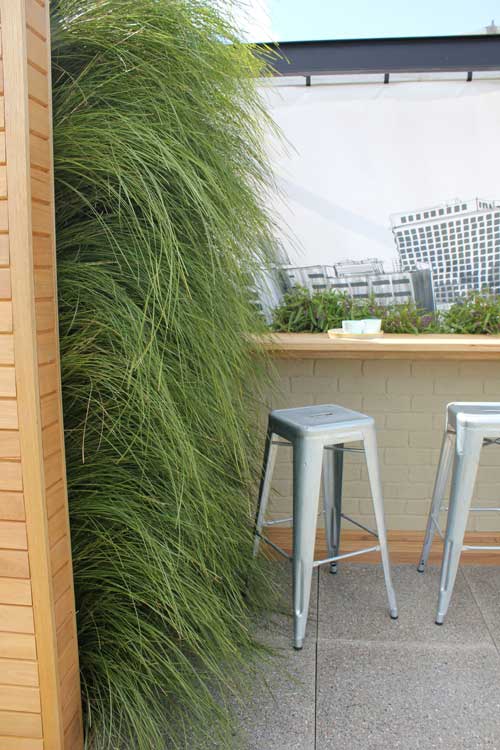
https://www.ozbreed.com.au/plant-ranges/strappy-leaf-plants/tanika-lomandra/
Purple Fusion™ Scaevola humilis ‘PFS100’ PBR
Purple Fusion™ Scaevola is a true ground cover with an exceptionally flat growth habit, setting it apart from other Scaevola forms. This plant produces an abundance of stunning purple flowers throughout the year, with the heaviest blooming period occurring from September to December. It requires minimal maintenance, as it does not mound, thereby reducing the need for frequent cutting back. If you’d like to prune the trailing stems, consider removing entire stems rather than hedge pruning to encourage its beautiful, natural cascading habit. Purple Fusion™ Scaevola is also more drought-tolerant compared to other varieties (except for Pink Fusion™ Scaevola), making it an excellent choice for various landscapes.
Size
Purple Fusion™ Scaevola typically reaches a height of 20 cm and can spread up to 1.5 metres in width. For optimal ground coverage, it is recommended to plant 1-2 plants per square metre.
Climate Tolerance
Purple Fusion™ Scaevola thrives in full sun to light shade and suits most soil types. It is highly tolerant of both cold and drought conditions, although it may struggle in the most extreme frosts of the ACT. To establish this plant successfully, it should be watered as required for 8-13 weeks and planted in a well-mulched bed with chunky mulch. If necessary, a slow-release fertiliser can be applied in spring, and the plant may be trimmed once a year to maintain a tidy appearance (either through hedge pruning or selectively removing larger stems). This plant is suitable for the following regions:
- Queensland
- New South Wales
- Victoria
- Tasmania
- South Australia
- Western Australia

Blue Horizon™ Eremophila glabra prostrate ‘EREM1’ PBR
Blue Horizon™ Eremophila is a low-growing ground cover plant with tidy blue-grey foliage and beautiful yellow flowers that bloom in winter. This plant has a denser ground cover form, owing to its shorter internodes, which result in less gaps and a more uniform appearance compared to other varieties.
Size
Blue Horizon™ Eremophila typically reaches a height of 25 cm and spreads up to 1 metre wide. For optimal coverage, it is recommended to plant 1-2 plants per square metre or 1-2 plants per linear metre.
Climate Tolerance
Blue Horizon™ Eremophila thrives in full sun to light shade and prefers free-draining soil. However, it can handle heavier soils in drier climates. This plant is highly drought-tolerant and well-suited for the following regions:
- South Australia
- Western Australia
- Victoria
- Sydney
- Southern New South Wales
In Sydney, it requires free-draining soil, and testing is still ongoing for regions north of Sydney. To establish this plant successfully, it should be watered as required for 8-13 weeks. Planting in a well-mulched garden with chunky mulch is recommended. For a more manicured look, pruning can be done in autumn or spring every 2-3 years.
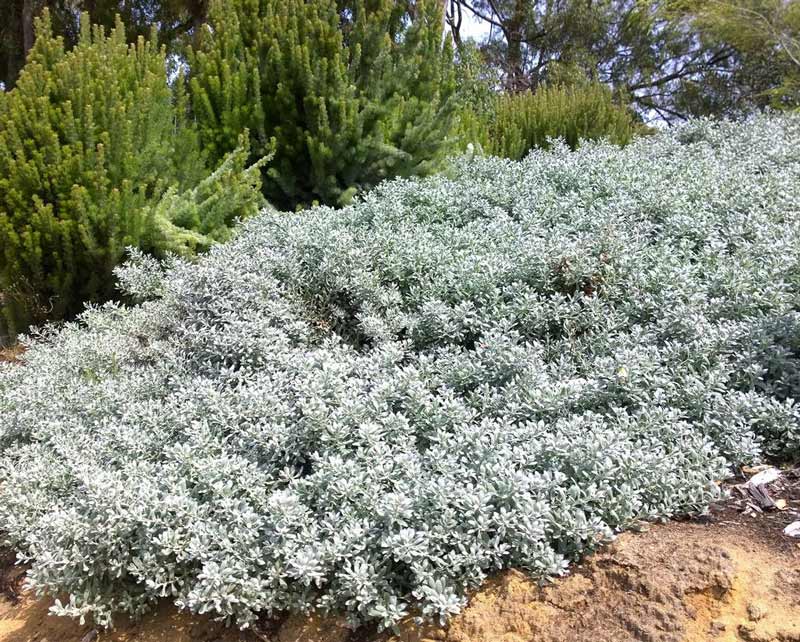
https://www.ozbreed.com.au/plant-ranges/native-shrubs-groundcovers/blue-horizon-eremophila/
Fire Bells™ Correa pulchella ‘COR11’ PBR Intended
Fire Bells™ Correa is a compact ground cover plant with vibrant orange/red flowers that bloom in winter and early spring. This dense Correa pulchella variety requires minimal pruning to maintain its compact form, making it ideal for raised beds and containers. Once established, the plant has low water requirements, adding to its appeal as a low-maintenance landscape option.
Size
Fire Bells™ Correa typically reaches a height of 25 cm and spreads up to 80 cm in width. For optimal coverage, it is recommended to plant 2-5 plants per square metre or 2-3 plants per linear metre. With regular pruning, it can be kept even smaller.
Climate Tolerance
Fire Bells™ Correa thrives in full sun to light shade and prefers reasonably drained soil, although it is adaptable to most soil types. It is drought-resistant and frost-tolerant, making it suitable for various climates that don’t get very humid. This plant is well-suited for the following regions:
- Victoria
- Australian Capital Territory
- South Australia
- Western Australia
- Tasmania
- Southern New South Wales
- Sydney (in well-draining soils)

Gold Cluster™ Grevillea juniperina ‘H22’ PBR
Gold Cluster™ Grevillea is a stunning ground cover plant with a dense growth habit and vibrant gold-yellow flowers. These spider-like flowers bloom prolifically in winter and spring, providing a striking contrast against the green foliage. This low-growing Grevillea is particularly effective at outcompeting weeds.
Size
Gold Cluster™ Grevillea typically reaches a height of 30 cm and spreads between 80 cm to 1 metre in width. For optimal coverage, it is recommended to plant 1-2 plants per square metre.
Climate Tolerance
Gold Cluster™ Grevillea thrives in full sun to part shade and is suitable for a range of soil types, from free-draining to moderately heavy soils. In Sydney, it prefers free-draining soils and should avoid soils with a pH above 7. This plant is highly tolerant of both frost and drought conditions. It is well-suited for the following regions:
- New South Wales (Sydney and south)
- Australian Capital Territory
- Victoria
- Tasmania
- South Australia
- Western Australia
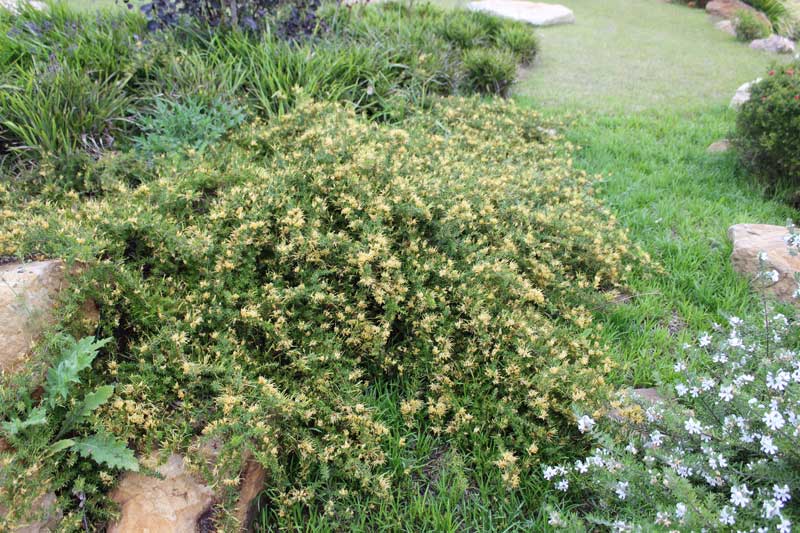
https://www.ozbreed.com.au/plant-ranges/native-shrubs-groundcovers/gold-cluster-grevillea/
Mundi™ Westringia fruticosa ‘WES05’ PBR
Mundi™ Westringia is a beautiful and adaptable ground cover plant that is celebrated for its resilience and low maintenance needs. This variety produces masses of white flowers and can be left unpruned while still maintaining a tidy form. Alternatively, it can be pruned into any low-growing architectural shape. Mundi™ Westringia is ideal for tough conditions, including poor soils, excess heat, as well as both serious flooding and drought.
Size
Mundi™ Westringia typically reaches a height of 40-50 cm and spreads up to 1.5 metres wide. For optimal coverage, it is recommended to plant 1-3 plants per square metre.
Climate Tolerance
Mundi™ Westringia thrives in full sun to part shade and suits a variety of soil types, from sandy to well-drained clay soils. It is highly tolerant of hot, cold, wet and drought conditions, making it robust enough to thrive on natural rainfall with poor drainage in most areas around Australia. This plant is suited for the following regions:
- Queensland
- New South Wales
- Victoria
- Tasmania
- South Australia
- Western Australia
- Australian Capital Territory (prefers shelter from heavy frost)
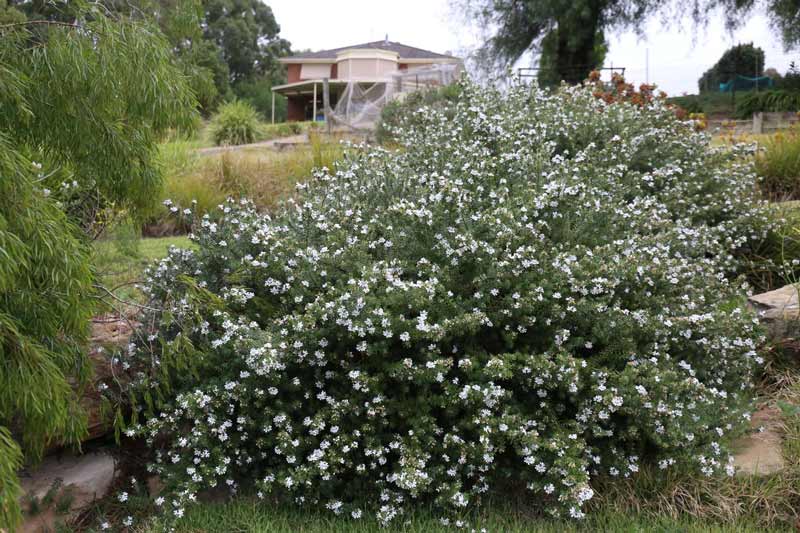
Green John™ Callistemon viminalis ‘LJ23’ PBR
Green John™ Callistemon is a low-growing, dense native shrub with attractive light green new growth, which contrasts beautifully with the older dark green foliage. This vibrant green backdrop enhances the striking red bottlebrush flowers that bloom from September to November. Green John™ Callistemon grows faster and establishes more quickly than its counterpart, Little John, and boasts high resistance to myrtle rust and phytopthora.
Size
Green John™ Callistemon typically reaches a height of 60 cm to 1 metre and spreads up to 60 cm wide. For optimal coverage, it is recommended to plant 3-6 plants per square metre or 2-2.5 plants per linear metre.
Climate Tolerance
Green John™ Callistemon thrives in full sun to part shade and is adaptable to a variety of soil types, from sandy to heavy soils. It tolerates both drought and cold conditions, as well as wet and dry conditions. This plant is suitable for the following regions:
- Queensland
- New South Wales
- Australian Capital Territory
- Victoria
- Tasmania
- South Australia
- Western Australia

Icy Burst™ Callistemon spp ‘CNU01’ PBR
Icy Burst™ Callistemon is a naturally narrow-growing shrub with fine leaves, making it an excellent choice for tight planting areas like raised beds. This compact variety features vibrant white bottle brush flowers in spring, which contrast beautifully with its dark green foliage. It is a low-maintenance plant that requires little to no pruning to maintain its narrow, upright form, and works as a screen with the added height of a raised planter.
Size
Icy Burst™ Callistemon typically reaches a height of 1.3 to 1.5 metres and spreads to a width of 70 to 80 cm. For optimal coverage, it is recommended to plant 1-3 plants per square metre or 1-2 plants per linear metre.
Climate Tolerance
Icy Burst™ Callistemon thrives in full sun to part shade and works well in most soil types. Once established, it has good drought and frost tolerance, making it suitable for various climates. This plant is particularly well-suited for the following regions:
- New South Wales
- Victoria
- South Australia
- Western Australia
- Southern Queensland (more testing required for Northern Queensland and the Australian Capital Territory)
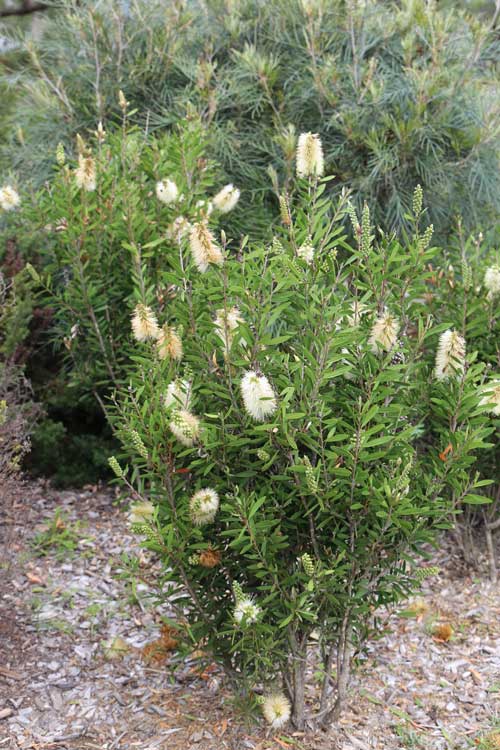
https://www.ozbreed.com.au/plant-ranges/native-shrubs-groundcovers/icy-burst-callistemon/
Slim™ Callistemon viminalis ‘CV01’ PBR
Slim™ Callistemon is a columnar bottlebrush shrub with a narrow growth habit, making it ideal for tight planting areas. This plant produces a multitude of flower buds in spring that open into classic bottlebrush flowers throughout spring, summer, and again in autumn. Another callistemon with a high resistance to myrtle rust and phytophthora, Slim™ Callistemon is an excellent choice for both landscape professionals and homeowners seeking a reliable and attractive screening or hedge solution in a raised bed or a difficult garden position. This variety will grow quite tall, and is best for larger raised beds.
Size
Slim™ Callistemon typically reaches a height of 3 metres and spreads to a width of 1.3 metres. For optimal coverage, it is recommended to plant 1-3 plants per square metre or 1-1.5 plants per linear metre.
Climate Tolerance
Slim™ Callistemon thrives in full sun to part shade and is adaptable to most soil types. It tolerates wet, dry, hot, humid and frost conditions, having been tested down to -6 degrees Celsius without leaf burn. This plant is well-suited for the following regions:
- Queensland
- New South Wales
- Australian Capital Territory
- Victoria
- Tasmania
- South Australia
- Western Australia
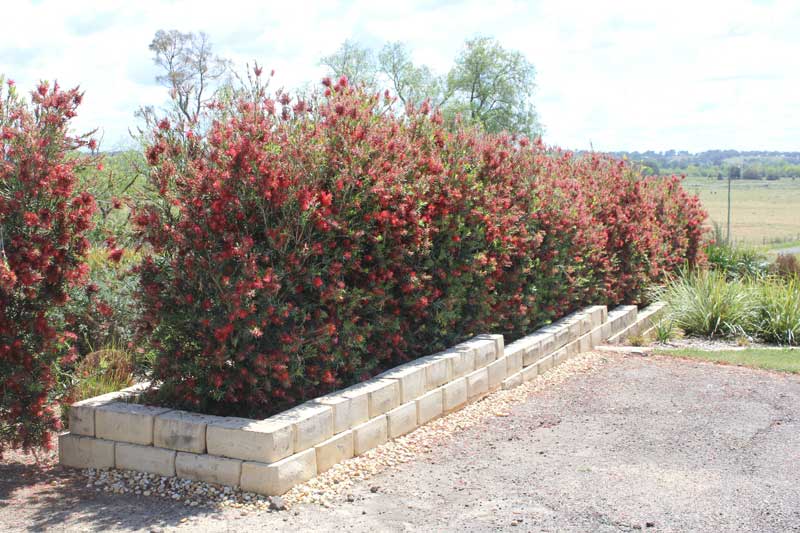
Ozbreed Flat White™ Pandorea jasminoides ‘PJ01’ PBR
Ozbreed Flat White™ Pandorea is a dense and compact climber renowned for its abundant pure white flowers that bloom in late spring and summer. This variety features more compact and dense foliage compared to other Pandorea species, making it an excellent choice for narrow spaces where you don’t want the plant to overtake the space or require lots of pruning to keep it tight. This variety requires minimal maintenance, needing pruning only twice a year to maintain its shape.
Size
Ozbreed Flat White™ Pandorea typically reaches a height of 2-3 metres. When pruned, it spreads to a width of 40-60 cm, but if left unpruned, it can spread between 80 cm to 2 metres. For optimal coverage, it is recommended to plant 1-3 plants per linear metre.
Climate Tolerance
Ozbreed Flat White™ Pandorea thrives in full sun to part shade and suits most soil types. It has moderate frost tolerance and good drought tolerance, making it adaptable to various climates. This plant is well-suited for the following regions:
- Southern Queensland
- New South Wales
- Victoria
- Tasmania
- South Australia
- Western Australia

https://www.ozbreed.com.au/plant-ranges/native-shrubs-groundcovers/ozbreed-flat-white/
All Seasons Pink™ Mandevilla spp ‘MANDI3018’ PBR Intended
All Seasons Pink™ Mandevilla is a robust and decorative climbing plant featuring vibrant hot pink blooms that appear from spring to autumn. This variety stands out due to its enhanced cold tolerance compared to other mandevillas, which tend to struggle when exposed to frost. It features dense, glossy foliage and a compact growth habit, making it suitable for both containers and as a decorative screen along fences or archways. The flowers are more vivid and deeper in colour than many other types of Mandevilla. (In case you’re wondering, yes it does come in red – search for All Seasons Red™ Mandevilla spp ‘MANDI301’ PBR Intended.)
Size
All Seasons Pink™ Mandevilla typically reaches a height of up to 1.5 metres when supported and spreads to a width of approximately 1.2 metres. For optimal coverage, it is recommended to plant 1 plant per square metre or 1 per linear metre.
Climate Tolerance
All Seasons Pink™ Mandevilla thrives in full sun to part shade and prefers well-drained soils, such as loam with organic material. It requires adequate irrigation during dry periods and regular watering in very free-draining soils, so make sure your irrigation is set up well in a raised bed. This plant exhibits improved cold tolerance, able to withstand light to moderate frosts, particularly when provided with some protection from nearby trees or buildings. It performs well in regions like:
- Queensland
- New South Wales
- Western Australia
- South Australia (testing required for other states)

https://www.ozbreed.com.au/plant-ranges/hardy-exotic-range/all-seasons-pink-mandevilla/
Conclusion
Raised beds offer a unique and beneficial environment for gardening, characterised by customisable soil conditions, improved drainage, and enhanced sunlight exposure. While they come with initial setup costs and increased watering needs, the benefits often outweigh the drawbacks for many gardeners.
Some plants struggle in raised planters, while others thrive. Hopefully this article has given you a great plant palette to work with – and don’t be afraid to experiment with plants not listed! Worst case scenario, they may die and need to be replaced but sometimes it’s worthwhile to try different plants out if they tickle your fancy.
